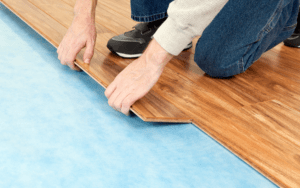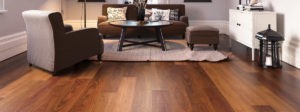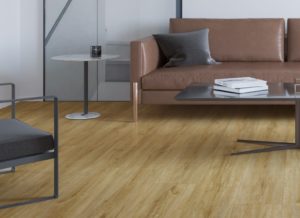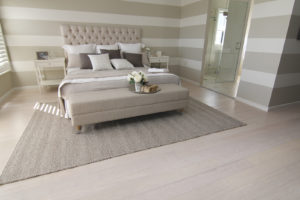

01 May Best Floating Timber Floors
Let’s face it – despite their natural beauty, traditional solid timber floors are a pain to install in your home. Not only do some timbers require a 2 week acclimatisation period before installation and need to be held down by nails or smelly glue, but they’re also quite costly to supply and install.
But what if we told you that you can get the look of real timber in your home without the hassle of a complicated installation and at a lower price?
It’s not too good to be true – the answer is floating timber floors. In this article, we’ll first understand what floating floors are before we take a comprehensive look through some floating floor types that have the exquisite timber look you’re searching for.
What are Floating Floors?
Floating floors get their name from how they’re not permanently stuck down to the bare timber or concrete subfloor, but rather ‘float’ above your existing floor (i.e. subfloor). How do they do this? Usually, floating floors use a click-lock construction that holds the floorboards together firmly without the need of any nails or glue. A layer of underlayment is also used between the subfloor and the floating floor to give support and absorb any noise.
If you’re reading this article, you probably already know a bit about floating floors – if not, we have a more comprehensive guide on floating floors here. Their main benefit is that they’re simple to install and uninstall, making them suitable for apartments and rental properties which don’t allow noisy nail banging during installations.
Meanwhile, the main drawbacks to floating floors are that your existing floor needs to be relatively flat and solid (which means that you can’t use them over carpet), and that floating floors sound a little more hollow than their traditionally solid counterparts.


4 Most Common Types of Floating Timber Floors
Engineered Timber Flooring
Engineered timber flooring is the easiest way to get a real hardwood or oak floorboards into your home. These floors use real timber but are cheaper than solid timber floors as they only use a thin timber veneer which is layered on top of a thicker plywood core. They also come in two different styles – Engineered Hardwood and Engineered Oak flooring.
Advantages of Engineered Timber Flooring
The primary benefit to engineered timber floors (beyond their great looks) is that you can now get 99% waterproof timber through our HydroPro Timber range. This makes it perfect if you intend to install them throughout your home including wetter areas like the kitchen and laundry. Engineered timber floorboards also have a hard-wearing, scratch-resistant top finish. If the timber veneer is 3mm or thicker, they can be sanded down and refinished once they start looking tired.
Disadvantages of Engineered Timber Flooring
The main drawback to engineered timber flooring is price – although they’re cheaper than solid timber, they just don’t last as long as they can’t be refinished as many times. Engineered timber is more expensive than hybrid, laminate, and vinyl floating floors as they do have real timber.


Hybrid Flooring
Hybrid floors are waterproof and aren’t made of real timber. Instead, they use high-tech printers to create a realistic wood surface on a resin that’s glued between a protective surface wear layer and composite core layer.
Advantages of Hybrid Flooring
Aside from being 100% waterproof, hybrid flooring is more affordable and more durable than engineered timber floors. Hybrid floors are also extremely stylish and can feature a wide variety of timber species designs! As such, they have grown significantly popular amongst home owners and apartments alike during recent years.
Disadvantages of Hybrid Flooring
Whilst they look similar to timber, they just can’t compare with the real deal. This is because they use print technology which means lower quality ranges may suffer from pattern repetition. Hybrid floorboards can also discolour if continually exposed to strong sunlight for long periods of time. Lastly, hybrid floorboards require a very even subfloor to ensure longevity as they are very thin and will otherwise move and damage in the long term.

Laminate Flooring
Laminate floorboards are constructed very similarly to hybrid floors – the only difference is that the core layer is composed of a more cost-effective High Density Fibreboard (HDF), which is essentially wood pulp fused into a robust board.
Advantages of Laminate Flooring
Like hybrid floors, laminate flooring really shines in terms of durability – in fact, laminate ranges offer the most scratch and impact resistant floor covering that you can get in your space. Furthermore, laminate floors also have a wide range of designs that you can choose from, ensuring that you can get a look that suits your vision perfectly. Finally, they are the most affordable flooring choice in the market and are known as the ‘budget’ options when it comes to getting a timber look into your home or office.
Disadvantages of Laminate Flooring
The main drawback of laminate floors compared to hybrid flooring is its lack of waterproofness – laminate floors are only water-resistant and should be used sparingly in places that see regular exposure to moisture. Laminate floors also suffer from the same problems as hybrid floors in terms of authenticity and pattern repetition, although these problems can be easily avoided if you choose from higher-quality options.


Bamboo Flooring
Whilst not technically ‘wood’, bamboo flooring is a trendy option that stands on its own with other timber floating floor alternatives. These floors are made of bamboo grass that’s been shredded and compacted to make robust floorboards.
Advantages of Bamboo Flooring
Bamboo floors are a great unconventional ‘timber floor’ as they’re incredibly sustainable – bamboo is a fast-growing and renewable material that uses less natural resources to grow than hardwoods like Blackbutt or Spotted Gum. Bamboo floors also have a stylish and unique grain that can be finished with a range of tones to suit your space. They’re also very durable and hard wearing – in fact, strandwoven bamboo floors are over 3 times as abrasion resistant as hardwood floors when it comes to the Janka hardness rating.
Disadvantages of Bamboo Flooring
However, bamboo floors aren’t waterproof, so they shouldn’t be exposed to water or excessive humidity. Bamboo ranges are also limited in terms of design, and their distinctive look can be off-putting to some people.






























